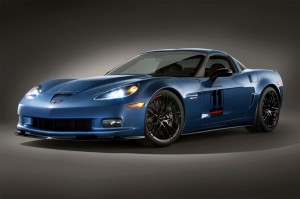
GM found a variety of applications for carbon fiber on the Chevrolet Corvette Z06 Carbon Limited Edition. Now it wants to mass produce the lightweight material.
General Motors hopes to bring the cost of one of the most promising space-age materials down to Earth.
Like a growing number of competitors, the U.S. giant believes there’s great potential for super-strong, ultra-light carbon fiber. And it has entered into a new joint venture it is betting will make it commercially feasible to bring to the mainstream market a material that traditionally only supercar makers could afford to use.
Dubbing carbon fiber-reinforced plastics, or CFRP, a “game changer,” GM Vice Chairman Steve Girsky inked a co-development deal with Japan’s Teijin Limited, a group of 150 companies focused largely on the use of advanced materials.
Teijin has been researching ways to produce CFRP parts and components at the high volumes needed by the mainstream auto industry. Traditional methods of using carbon fiber are slow and labor-intensive, requiring the use of special molds and slow-curing resins. As a result, only limited numbers of pieces could be produced – at costs that have largely restricted the use of the composite materials to high-line supercars from the likes of Ferrari or Lamborghini.
But Teijin has developed a process that can produce a CFRP part in under a minute – closer to the time required by modern automotive plastics. The process helped the Japanese firm win an Innovation Award, earlier this year, from consulting firm Frost & Sullivan, among other accolades.
“Our relationship with Teijin provides the opportunity to revolutionize the way carbon fiber is used in the automotive industry,” said GM Vice Chairman Girsky. “This technology holds the potential to be an industry game changer and demonstrates GM’s long-standing commitment to innovation.”
Carbon fiber materials have become commonplace in racing applications, as well as in supercar design. That’s because the composites are as much as 10 times stronger than standard-grade steels yet barely a quarter of the weight.
That presents some significant advantages when it comes to performance cars, but even more opportunities in the mainstream automotive market where makers like GM are struggling to meet stiff new fuel economy standards that, in the U.S., will nudge 54 mpg by 2025. Cutting weight is one of the most effective ways of improving mileage, industry experts note.
GM and Teijin aren’t setting out a specific timeline for launching CFRP production for mainstream products but it is clear they have to consider the competitive press of today’s automotive market. BMW has inked a number of recent deals aimed at mass producing composites and plans to use the materials extensively when it launches the new i3 and i8 battery car models. Toyota has also been working on ways to advance CFRP manufacturing. The maker turned to its roots as a fabric producer, developing a special looming process used to produce carbon fiber pieces for the Lexus LF-A supercar. Toyota still hasn’t found a way to achieve mass market speeds and costs, however.
But there’s a growing sense that carbon fiber will make that giant leap, perhaps before decade’s end.
“We believe our visionary relationship with GM will lead the way in increased usage of green composites in the automotive industry,” said Norio Kamei, senior managing director of Teijin.
